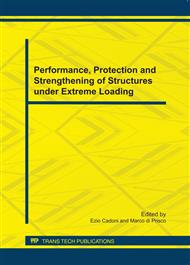p.728
p.734
p.740
p.746
p.752
p.758
p.764
p.770
p.778
An Experimental Study on Fire Resistance of Slim Floor Beam
Abstract:
Composite beam using asymmetric H-shaped steel is one of the constructional structures developed in the advanced countries in Europe since early 1990s. The purpose of this study on composite beams where H-shaped steel is partially laid in concrete slabs was to find how to design fire protection and improve fire-resistance to make deep deck plates provide the beams with advantages upon a fire and to improve stiffness in structural aspect. Only lower flange which is directly exposed to a fire was included in fire-resistance design in order to decide optimal fire- protection design condition and test was conducted for spray-coating and paint-coating. In the fire resistance test, web thickness and lower flange thickness were varied to derive the optimum condition for improving fire-resistance performance. It was observed from the test that 90-minute-protection employed to lower flange provided fire resistance for 3 hours. It was also observed that the basic shape resisted fire for 89 minutes, while web reinforcement and lower flange reinforcement provided fire-resistance for 112 and 157 minutes, respectively. The result showed that lower flange reinforcement is the most effective way to improve fire-resistance.
Info:
Periodical:
Pages:
752-757
Citation:
Online since:
July 2011
Authors:
Keywords:
Price:
Сopyright:
© 2011 Trans Tech Publications Ltd. All Rights Reserved
Share:
Citation:


